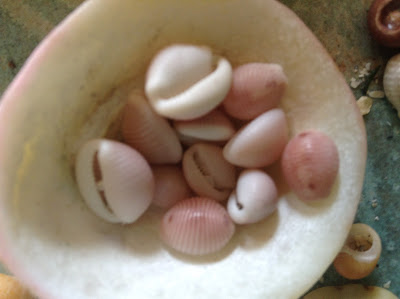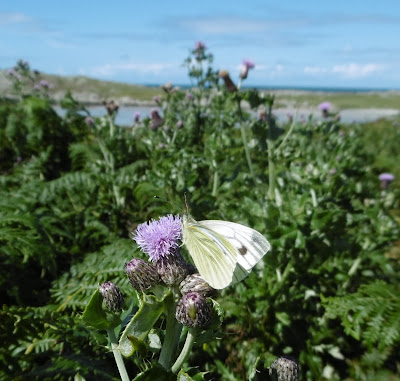I promised to return to the subject of the Ear Moth found in my granddaughter's buggy on Colonsay, and here I am, doing so.
Warning: I do so at some length. I've found it interesting, especially as it led me to an online version, hosted by Butterfly Conservation, of
a superb but out-of-print book on identifying difficult UK macromoths.
Faithful readers do not need telling about my deficiencies in this department; and reading about the differences between the four types of Ear - standard, Large, Crinan and Saltern - does not fill me with optimism about my chances of improving. This is partly because to be absolutely sure of an Ear's ID, there is no alternative to killing and dissecting the insect. That is the only way to see the minute differences in the genitalia which incontrovertibly tell them apart.
Here they are, below, in Richard Lewington's brilliant paintings in
the Moth Bible. They presented him with an impossible challenge; although they look slightly different on the page, the range and variety of colours and patterns found in all four makes the notion of a 'type' specimen for any of them idle.
The online book is more encouraging about other similar species which cause me grief, so I can say genuinely: I will try harder. My Ear question is however insoluable; all four species are found in the Hebrides and my actual moth is hundreds of miles away on Colonsay and safe from dissection (although the chances are that it is inside the tummy of a bat or bird).

The fact that the four different species have been teased apart is a tribute to human curiosity and it intrigued me to know who came across the differences in a moth which the great Linnaeus classified simply as
Amphipoea oculea, the standard Ear, in the 1760s. The Large and Saltern Ears were named by the German entomologist Christian Friedrich Freyer (1794-1885) who has a great many eponymous insects including Freyer's Fritillary and Freyer's Pug. He looks a cheery soul - see Wikipedia picture left. The Crinan followed almost a century later, thanks to Rev Charles Rich Nelson Burrows, vicar of Mucking in Essex from 1897 to 1933. I was discussing these complex matters over early morning tea with Penny this morning and she said: "It was probably all down to one of those 19th century vicars with not much else to do." You can see why I married her.
Crinan, meanwhile. is a village in Argyll and 'saltern' refers to seawater pools left to evaporate for the salt they contain. To add further complications, there is a sub-species
paludis of the Saltern Ear, discovered by the great Victorian entomologist William Tutt, and there are areas in western Scotland where the Large and Saltern Ears have hybridised and specimens found with what are un-nervingly called 'intermediate genitalia'.

For your delectation and to tempt you to visit Butterfly Conservation's online site, here is a screenshot of the four different sets of 'bits'.
A final question which occurred to me relates to the scientific names of the four. They all share the 1820s coining of
Amphipoea, meaning 'both or two' of something - I'm not yet sure what. Their second names are
oculea (eye-like) for the standard Ear Moth,
lucens (shining) for the Large Ear,
fucosa (beautified) for the Saltern and
crinanensis (from Crinan) for the Crinan.
Paludis means 'of the swamp or marsh'. Perhaps the second and third of these refer to aspects of the moths' genitalia but if so, I do not see it myself.
The issue of killing moths, which most enthusiasts used to do before the invention of today's excellent digital cameras, came up via a brief return to journalism which I undertook while away. My old employer the
Guardian emailed, asking me to write a Comment piece on the suggestion from Butterfly Conservation that moth-trapping has become the UK's fastest-growing natural history hobby. Hooray, if so.
I was a bit reluctant, being on holiday, but the call of the moth proved too strong, so I got up early and bashed it out. Things were made slightly more dramatic by my iPad's failure to save the article twice, on each occasion when I'd almost finished it but had to check something. But luckily my memory cells still work. If interested,
you can read it here.
The thread of readers' views repays reading, as usual, and I was interested in the level of concern about not killing things. I share this, although there is little or no sentiment shown in the daily slaughterhouse which is the world of wild creatures. But this, admittedly rather long, essay on the Ears maybe shows why it sometimes has to be done.





















































